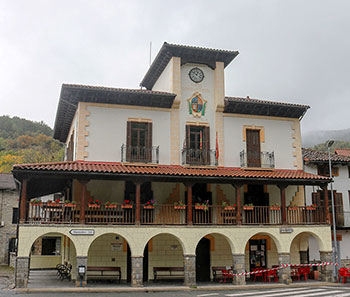Navarrese town councils (III):
merindades of Sangüesa and Tudela
By Eduardo Morales Solchaga
|
|
|
|
|
|
|
|
|
|
|
|
|
|
|
|
|
|
|
|
|
|
|
|
|
|
Roncal, a house for the Valley
Since ancient times, the seven villages of the Roncal Valley (Uztárroz, Isaba, Urzainqui, Roncal, Garde, Vidángoz and Burgui) formed an indissoluble unit, governed by the same ordinances and statutes, with shared rights over their meadows, woods and forests. For the management of their political and economic affairs, each village appointed two deputies and a mayor, who exercised civil and criminal jurisdiction.
The General Assemblies of the Valles have been held in different localities and the seats of meeting were at first sacred places (sacristy of the church of Roncal or the Shrine of Our Lady of Fair Love of San Martín, belonging to the monastery of Leyre), such as hermitages or churches, and later premises built specifically for this purpose. In the 17th century, the presence of a specific building to cover the aforementioned functions was already detected, first in the form of a council house, and later -already in the 19th century- in the so-called Casa del Valle, located in Roncal and in which all the aforementioned towns participated. It was located in a place next to the parish church of San Esteban, next to the town hall of Roncal-villa, the communal granary and the butcher's shops, and also housed the general file .
The present house, next to the bridge of the entrance of Roncal, was inaugurated in 1956. It is a beautiful Building of subject mountain with simple lines and robust appearance. It has two floors topped by a powerful eave and is covered with a steeply pitched hipped roof with flat tiles. On the main facade, stone is used in the arcades, corners, cornice and around the openings of entrance and rectangular windows, while the rest is plastered.
Its noble area, in the center, forms an advanced nucleus with a semicircular doorway with large voussoirs. The rectangular, projecting balcony rests on sturdy stone corbels, and at the top, on the gable, is the coat of arms of the Roncal valley with its four quarters, helmet and crest, and lions holding the lions. The front is crowned by a clock and the registration "Casa Consistorial". Two elegant wrought iron lanterns and the bars of the balcony of the door adorn this area.
Inside, and apart from the conference room of meetings, there is also a large auditorium where forest auctions are held, luxurious and traditional costumes of Roncaleses are exhibited, and pastries and tapestries with the arms of the Valley and the Kingdom, under the gaze of a gallery of oil portraits of the most illustrious Roncaleses, work of the painter Escartín Bescós, among which are Captain Pedro Navarro, the martyr missionary Cipriano Barace (S.J.), the colonel and mayor of the Valley, Pedro Vicente Gambra, the guerrilla Gregorio de Cruchaga and, of course, the most universal person from Roncal, Julián Gayarre.
ANDUEZA UNANUA, P. and ORTA RUBIO, E., Panorama n.º 38: Corella, Pamplona, Government of Navarra, 2008.
ANDUEZA UNANUA, P., "La arquitectura señorial de Navarra y el espacio doméstico durante el Antiguo Régimen", in Cuadernos de la Chair de Patrimonio y Arte Navarro, n.º 4, 2009, pp. 219-263.
ANDUEZA UNANUA, P., Patrimonio y familia: la casa y el espacio doméstico en Navarra, Pamplona, Chair de Patrimonio y Arte Navarro, 2019.
AZANZA LÓPEZ, J. J., "Casas consistoriales navarras: urbanismo, morfología y evolución tipológica", in Cuadernos de la Chair de Patrimonio y Arte Navarro, n.º 4, 2009, pp. 69-103.
FERNÁNDEZ GRACIA, R. [Coord.], El Arte del Barroco en Navarra, Pamplona, Gobierno de Navarra, 2014.
GARCÍA GAÍNZA M.ª C. and FERNÁNDEZ GRACIA, R., El Arte del Renacimiento en Navarra, Pamplona, Government of Navarra, 2006.
LABEAGA MENDIOLA, J. C., Panorama n.º 22: Sangüesa, Pamplona, Government of Navarra, 1994.
LARUMBE MARTÍN, M., Academicismo y la arquitectura del siglo XIX en Navarra, Pamplona, Government of Navarra, 1990.
ORTA RUBIO, E., Panorama n.º 41: Tudela, Pamplona, Government of Navarra, 2009.
TARIFA CASTILLA, M.ª J., "La Casa de la Villa de Cascante a la luz de la contratación y trazas del Siglo XVI", in Revista del Centro de programs of study Merindad de Tudela, n.º 24, 2016, pp. 7-64.
VV. AA., Casas consistoriales de Navarra, Pamplona, Government of Navarra, 1988.
VV. AA., Catalog Monumental de Navarra: Merindad de Tudela, Pamplona, Government of Navarra, 1980.
VV. AA., Catalog Monumental de Navarra: Merindad de Sangüesa, Pamplona, Government of Navarra, vol. I, 1989.
VV. AA., Catalog Monumental de Navarra: Merindad de Sangüesa, Pamplona, Government of Navarra, vol. II, 1992.
VV. AA., Gran Enciclopedia de Navarra, Pamplona, Caja de Ahorros de Navarra, 1990.
Newspaper libraries of Diario de Navarra and Diario de Noticias.
Websites of the Town Councils of Ablitas, Arguedas, Cascante, Corella, Tudela, Villafranca, Lumbier, Roncal and Sangüesa.










